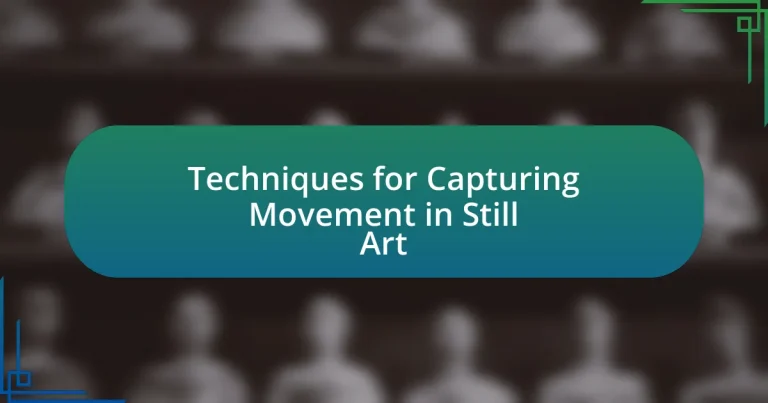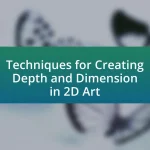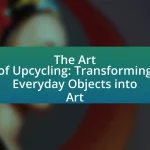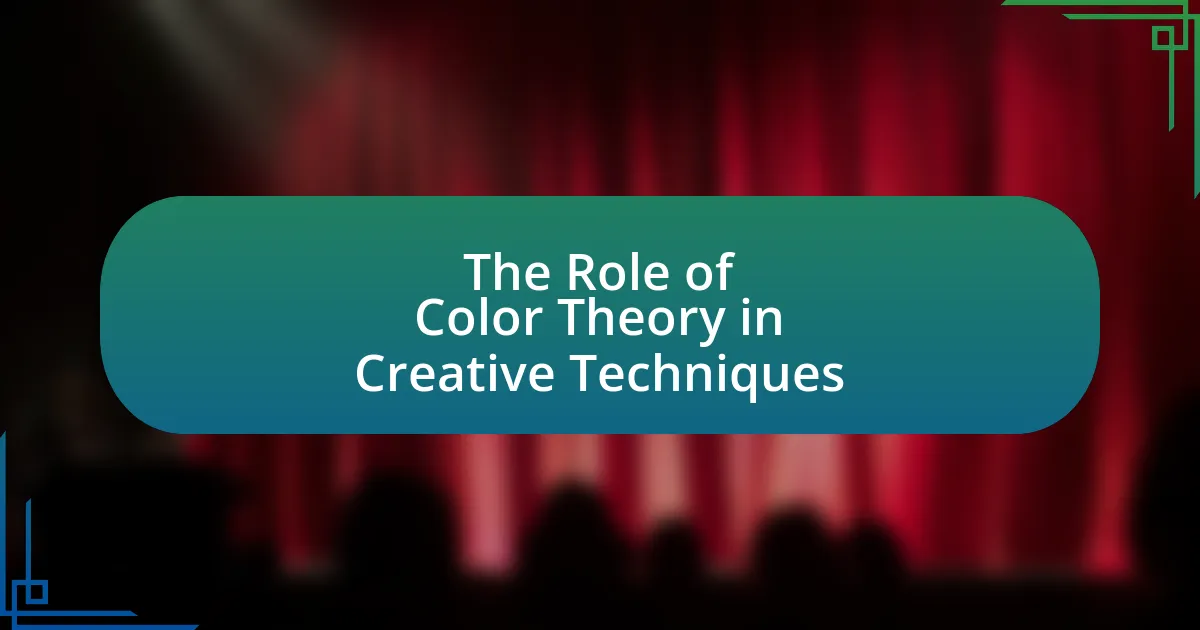The article focuses on techniques for capturing movement in still art, highlighting methods such as blurring, dynamic composition, and implied motion. It discusses how artists convey movement through visual elements like lines, shapes, and color contrasts, and emphasizes the importance of composition in influencing the perception of motion. Additionally, the article explores various methods, including gesture drawing and sequential art, as well as the impact of different mediums and tools on the portrayal of movement. It also addresses the emotional responses elicited by movement in art and offers best practices for artists to enhance their skills in representing motion effectively.

What are the Techniques for Capturing Movement in Still Art?
Techniques for capturing movement in still art include the use of blurring, dynamic composition, and implied motion. Blurring can be achieved through techniques like motion blur in painting or photography, where the subject appears to be in motion, creating a sense of speed. Dynamic composition involves arranging elements in a way that leads the viewer’s eye along a path, suggesting movement, often utilizing diagonal lines or asymmetry. Implied motion can be depicted through the positioning of figures or objects, such as a figure in mid-leap or a flowing fabric, which conveys the idea of movement even in a static image. These techniques are validated by art history, where artists like Edgar Degas and Giacomo Balla effectively employed these methods to evoke a sense of motion in their works.
How do artists convey movement in their artwork?
Artists convey movement in their artwork through techniques such as dynamic composition, the use of lines, and color contrasts. Dynamic composition involves arranging elements in a way that guides the viewer’s eye along a path, creating a sense of action. For example, in Edgar Degas’ ballet paintings, the positioning of dancers creates an illusion of motion. The use of lines, such as diagonal lines, can suggest movement and energy, as seen in the works of Giotto and later in Futurism, where artists like Umberto Boccioni emphasized the fluidity of motion. Additionally, color contrasts can evoke a sense of speed or stillness; vibrant colors can suggest energy, while muted tones may imply a pause. These techniques are supported by art theory, which emphasizes the importance of visual elements in creating the illusion of movement.
What visual elements are essential for depicting motion?
Essential visual elements for depicting motion include lines, shapes, color, and composition. Lines, particularly diagonal or curved lines, create a sense of direction and speed, while shapes can suggest movement through their arrangement and form. Color can evoke emotional responses and enhance the perception of motion; for example, warm colors may imply energy and action. Composition plays a crucial role by guiding the viewer’s eye along a path that suggests movement. These elements are validated by principles in art and design, where dynamic compositions often utilize these techniques to convey action effectively.
How does composition influence the perception of movement?
Composition significantly influences the perception of movement by guiding the viewer’s eye and creating a sense of dynamism within the artwork. Elements such as line direction, balance, and focal points can suggest motion; for instance, diagonal lines often convey action and energy, while the arrangement of subjects can imply a narrative progression. Research by the psychologist Richard E. Mayer indicates that visual composition affects cognitive processing, enhancing the viewer’s interpretation of movement through structured visual cues. Thus, effective composition not only captures movement but also enhances the emotional and narrative impact of still art.
Why is capturing movement important in still art?
Capturing movement is important in still art because it conveys dynamism and emotion, enhancing the viewer’s engagement with the artwork. By depicting movement, artists can create a sense of life and action, allowing the audience to connect more deeply with the subject matter. For example, the use of blurred lines or dynamic poses in paintings can evoke feelings of speed or tension, as seen in the works of artists like Edgar Degas, who often portrayed dancers in motion. This technique not only enriches the narrative of the artwork but also invites viewers to interpret the scene actively, making the experience more immersive.
What emotional responses does movement evoke in viewers?
Movement evokes a range of emotional responses in viewers, including excitement, nostalgia, and tension. These emotions arise because movement can suggest action, energy, and dynamism, which engage the viewer’s imagination and feelings. For instance, artworks that depict figures in motion often create a sense of urgency or thrill, while scenes that capture fleeting moments can evoke nostalgia or reflection. Research indicates that visual representations of movement can stimulate the brain’s mirror neurons, which are associated with empathy and emotional resonance, thereby enhancing the viewer’s emotional experience.
How does movement enhance storytelling in art?
Movement enhances storytelling in art by conveying emotion, action, and narrative progression. Artists utilize techniques such as dynamic lines, gestural brushwork, and compositional elements to suggest movement, which engages viewers and evokes a sense of time and space. For instance, in Edgar Degas’ ballet paintings, the depiction of dancers in motion captures the grace and energy of performance, allowing the audience to feel the rhythm and excitement of the scene. This ability to represent movement not only enriches the visual experience but also deepens the narrative, making the artwork more relatable and impactful.

What are the Different Methods Used to Capture Movement?
The different methods used to capture movement include gesture drawing, dynamic poses, and sequential art techniques. Gesture drawing involves quickly sketching the essence of a subject’s movement, emphasizing fluidity and action. Dynamic poses capture the energy and motion of a figure in a single frame, often using exaggerated angles and perspectives to convey movement. Sequential art techniques, such as comic strips or storyboards, depict movement over time through a series of images, allowing viewers to perceive the progression of action. These methods are validated by their widespread use in art education and professional practice, demonstrating their effectiveness in conveying movement in still art.
How do traditional techniques differ from modern approaches?
Traditional techniques for capturing movement in still art primarily rely on manual methods such as brushwork, composition, and perspective to convey dynamism, while modern approaches often utilize technology, including digital tools and animation techniques, to achieve a more fluid representation of motion. For instance, traditional artists like Edgar Degas employed techniques such as capturing fleeting moments through careful observation and brush strokes, whereas contemporary artists may use software like Adobe After Effects to create animated sequences that simulate movement. This shift reflects a broader evolution in artistic practice, where modern methods allow for greater experimentation and precision in depicting motion.
What role does brushwork play in depicting movement?
Brushwork plays a crucial role in depicting movement by creating dynamic lines and textures that suggest action and fluidity. Artists utilize varied brushstroke techniques, such as quick, short strokes or sweeping, elongated strokes, to convey the sense of motion within a still image. For instance, in Impressionism, artists like Claude Monet employed loose, rapid brushwork to capture the ephemeral quality of light and movement in nature, effectively making the viewer feel the vibrancy of the scene. This technique allows the viewer to perceive movement not just as a static representation but as an active experience, enhancing the emotional impact of the artwork.
How can color and light be manipulated to suggest motion?
Color and light can be manipulated to suggest motion by using techniques such as blurring, contrasting colors, and dynamic lighting. Blurring, achieved through soft edges or gradient transitions, creates a sense of speed and fluidity, as seen in impressionist paintings where movement is implied rather than explicitly depicted. Contrasting colors can evoke a sense of direction and energy; for example, warm colors can suggest forward motion while cool colors may imply retreat. Dynamic lighting, such as highlighting certain areas while casting shadows elsewhere, can create depth and a sense of movement, as demonstrated in works by artists like Caravaggio, who used chiaroscuro to enhance the perception of action. These methods effectively engage viewers’ perceptions, allowing them to interpret still images as dynamic scenes.
What are some specific techniques artists use?
Artists use techniques such as dynamic composition, gesture drawing, and the use of color to convey movement in still art. Dynamic composition involves arranging elements in a way that suggests action or flow, often utilizing diagonal lines and asymmetry to create a sense of energy. Gesture drawing captures the essence of movement through quick, fluid strokes, allowing artists to depict the posture and motion of subjects effectively. The use of color can also enhance the perception of movement; for instance, warm colors may suggest energy and action, while cool colors can imply calmness or stillness. These techniques are supported by studies in art theory, which emphasize the importance of visual dynamics in creating the illusion of movement.
How does the use of lines create a sense of direction?
The use of lines creates a sense of direction by guiding the viewer’s eye along a specific path within the artwork. Lines can be straight, curved, or diagonal, and their orientation influences how movement is perceived; for instance, diagonal lines often suggest dynamism and action, while horizontal lines can evoke calmness and stability. This directional quality of lines is supported by principles of visual perception, where the brain interprets the arrangement and angles of lines to infer movement and flow, enhancing the overall narrative of the piece.
What is the significance of blurring in movement representation?
Blurring in movement representation is significant because it visually conveys the dynamism and fluidity of motion in still art. This technique allows artists to depict the passage of time and the energy of movement, creating a sense of realism and engagement for the viewer. For instance, in the works of artists like Edgar Degas, blurring effectively captures the essence of ballet dancers in motion, emphasizing their grace and speed. This approach not only enhances the emotional impact of the artwork but also invites viewers to interpret the movement, making the experience more immersive.

What Tools and Materials Aid in Capturing Movement?
Tools and materials that aid in capturing movement include cameras, tripods, and specialized lenses. Cameras, particularly DSLRs and mirrorless models, allow for high-speed photography, enabling the capture of fast-moving subjects with clarity. Tripods provide stability, essential for long exposure shots that convey motion blur, while specialized lenses, such as telephoto or wide-angle, can enhance the perception of movement by altering the perspective. Additionally, software for digital editing can further manipulate images to emphasize movement, making these tools integral to the process of depicting motion in still art.
How do different mediums affect the portrayal of movement?
Different mediums significantly influence the portrayal of movement in still art by altering the visual dynamics and techniques used to convey motion. For instance, oil painting allows for smooth blending and layering, which can create a sense of fluidity and grace in the depiction of movement, as seen in the works of artists like Edgar Degas, who captured dancers in motion with soft brush strokes. In contrast, mediums like charcoal or ink can produce sharper lines and contrasts, emphasizing the energy and immediacy of movement, as demonstrated in the dynamic sketches of artists such as Giacomo Balla, who utilized rapid strokes to convey speed. Additionally, digital mediums offer unique capabilities, such as animation and layering effects, which can simulate movement in a way traditional mediums cannot, allowing for a more interactive experience. Thus, the choice of medium directly impacts how movement is interpreted and represented in still art.
What are the advantages of using oil paints versus watercolors?
Oil paints offer several advantages over watercolors, particularly in their versatility and depth of color. The thicker consistency of oil paints allows for richer textures and more vibrant hues, enabling artists to create a wider range of effects. Additionally, oil paints have a longer drying time, which provides artists with the opportunity to blend colors and make adjustments over an extended period, facilitating the capture of movement in still art. This extended working time is crucial for achieving subtle gradations and dynamic compositions. Furthermore, oil paints can be layered to create depth and luminosity, enhancing the visual impact of the artwork. These characteristics make oil paints particularly suitable for techniques that aim to convey movement and emotion in still art.
How can digital tools enhance the depiction of motion?
Digital tools enhance the depiction of motion by allowing artists to create dynamic visual effects that simulate movement. Software such as Adobe After Effects and Blender enables the manipulation of images and animations, providing features like motion blur, frame-by-frame animation, and 3D modeling. These tools facilitate the integration of real-time physics simulations, which can accurately represent how objects move and interact in space. For instance, the use of keyframing in animation software allows for precise control over the timing and speed of motion, resulting in a more lifelike representation. Additionally, digital tools can incorporate techniques like layering and transparency to convey depth and fluidity, further enhancing the visual experience of motion in still art.
What techniques can artists employ to improve their skills in capturing movement?
Artists can improve their skills in capturing movement by employing techniques such as gesture drawing, studying anatomy, and utilizing dynamic compositions. Gesture drawing allows artists to quickly capture the essence of movement through rapid sketches, enhancing their ability to depict fluidity and action. Studying anatomy provides a deeper understanding of how the human body moves, enabling artists to represent realistic motion. Additionally, dynamic compositions, which involve the use of diagonal lines and asymmetry, can create a sense of movement within a still artwork. These techniques are supported by the practice of life drawing sessions, where artists observe live models in motion, further refining their skills in depicting movement accurately.
What exercises can help artists practice movement representation?
Artists can practice movement representation through gesture drawing, which involves quickly sketching the human figure in motion to capture the essence of movement. This exercise enhances an artist’s ability to observe and depict dynamic poses and fluidity in their work. Studies show that regular practice of gesture drawing can significantly improve an artist’s understanding of anatomy and movement dynamics, as it encourages the artist to focus on the overall form and rhythm rather than minute details. Additionally, life drawing sessions with models in various poses can further reinforce these skills, allowing artists to translate observed movement into their artwork effectively.
How can studying motion in real life inform artistic techniques?
Studying motion in real life can significantly inform artistic techniques by providing artists with a deeper understanding of how movement occurs and how to represent it effectively in their work. This understanding allows artists to capture the dynamics of motion, such as speed, direction, and fluidity, which can enhance the realism and emotional impact of their art. For example, artists like Edgar Degas studied dancers in motion to depict their grace and energy, resulting in works that convey a sense of movement and life. Additionally, techniques such as gesture drawing, which focuses on the essence of movement, are directly influenced by observing real-life motion, enabling artists to create more dynamic and expressive compositions.
What are some best practices for capturing movement in still art?
To effectively capture movement in still art, artists should utilize techniques such as dynamic composition, blurring effects, and gesture drawing. Dynamic composition involves arranging elements in a way that suggests motion, often through diagonal lines or asymmetrical balance, which can create a sense of energy and direction. Blurring effects can be achieved by depicting motion lines or using softer edges around moving subjects, which visually conveys speed and fluidity. Gesture drawing, focusing on the essence of movement rather than details, allows artists to capture the spontaneity and rhythm of the subject. These practices are supported by studies in visual perception, which indicate that viewers interpret certain visual cues as indicators of movement, enhancing the overall impact of the artwork.




